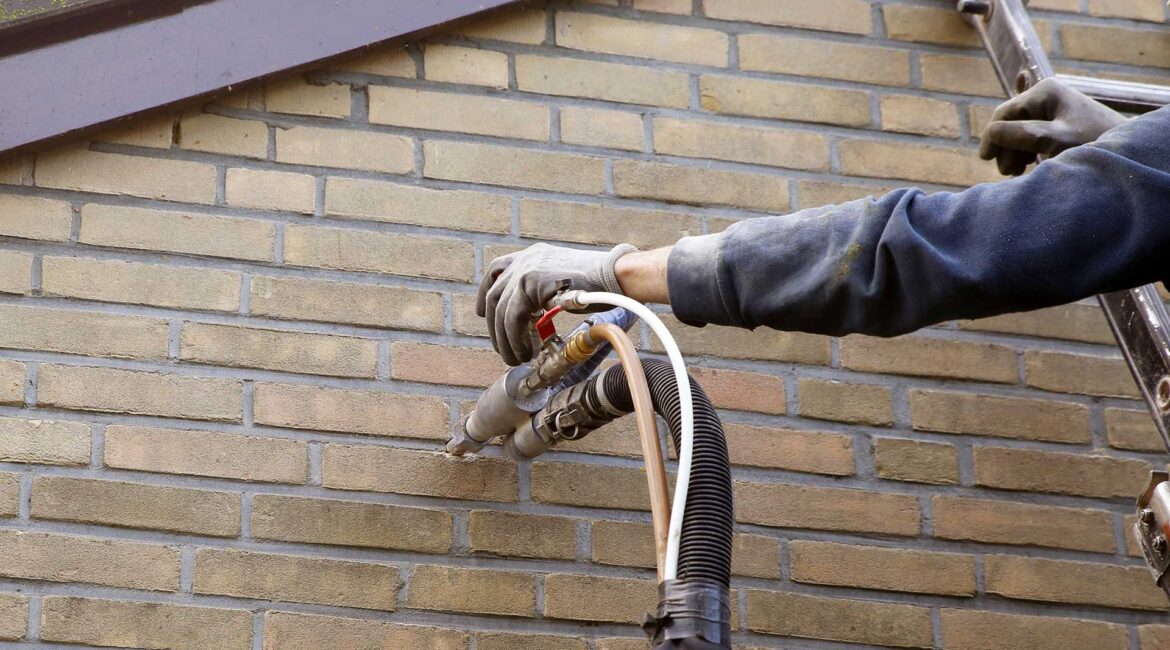What is cavity wall insulation?
Before we dive into the various types of cavity wall insulation available on the market, let us explain what cavity wall insulation is. Cavity wall insulation is a method used to fill the gap between the two layers of masonry in cavity walls, improving thermal efficiency and reducing heat loss in buildings and regulating the overall temperature of the home or building. Cavity wall insulation does not last forever and needs to be replaced either due to age or a degradation of quality due to damp, pests, or structural issues. You can learn more in our article “When is it Time to Remove Your Cavity Wall Insulation?”.
What are the main types of cavity wall insulation?
The main types of cavity wall insulation are:
- Foam Insulation: Includes polyurethane and phenolic foams.
- Mineral Wool Insulation: Rock wool and glass wool.
- Bead Insulation: Expanded polystyrene (EPS) beads.
- Blown-in Insulation: Cellulose and other fibrous materials.
What is foam insulation?
Pros:
- Higher Thermal Resistance: Foam insulation typically has a higher R-value per inch compared to traditional insulation materials like fiberglass, which means it provides better thermal resistance.
- Energy Efficiency: Spray foam acts as an air barrier, reducing air leaks and drafts, which enhances overall energy efficiency.
- Moisture Resistance: Closed-cell spray foam and rigid foam panels are resistant to moisture, reducing the risk of mold and mildew growth.
- Soundproofing: Foam insulation can help reduce noise transmission through walls, creating a quieter indoor environment.
- Structural Strength: Closed-cell spray foam adds structural strength to walls due to its rigidity and adhesion properties.
Cons:
- Cost: Foam insulation is generally more expensive than traditional insulation materials, both in terms of material and installation costs.
- Installation Complexity: Spray foam requires professional installation to ensure proper application and avoid issues such as overspray and uneven coverage.
- Potential for Off-Gassing: Some foam insulation materials can emit volatile organic compounds (VOCs) during and shortly after installation, which may require ventilation.
- Fire Hazard: Foam insulation needs to be covered with a thermal barrier, such as drywall, to meet fire safety codes, as it can emit toxic fumes when burned.
- Environmental Concerns: The production of foam insulation involves chemicals and can have a higher environmental impact compared to some other insulation materials.
What is mineral wool insulation?
Mineral wool insulation, also known as rock wool or stone wool, is a type of insulation made from natural minerals, typically basalt or diabase, and sometimes slag (a byproduct of steel production). These materials are melted at high temperatures and then spun into fibers to create a dense, fibrous mat. This process results in a highly effective insulating material with several advantageous properties. The pros and cons of mineral wool insulation include:
Pros:
- High Thermal Efficiency: Provides excellent thermal insulation, contributing to energy savings and comfort.
- Fire Safety: Non-combustible and can act as a fire barrier, enhancing building safety.
- Sound Insulation: Effective at reducing noise transmission.
- Moisture Resistance: Repels water and helps prevent mold and mildew growth.
- Durability: Long-lasting and maintains its insulating properties over time.
- Environmental Impact: Often made from natural and recycled materials, making it a more environmentally friendly option.
Cons:
- Cost: Typically more expensive than some other types of insulation, such as fiberglass.
- Installation: Can be more difficult to install than some other materials, particularly if dealing with rigid boards or needing to fit batts into irregular spaces.
- Dust and Irritation: The fibers can cause skin, eye, and respiratory irritation if proper protective gear is not used during installation.
What is bead insulation?
EPS bead insulation, also known as Expanded Polystyrene (EPS) bead insulation, is a type of foam insulation made from polystyrene beads that are expanded and fused together to form a lightweight, rigid material. This insulation is commonly used in a variety of applications, including wall insulation, underfloor insulation, and roof insulation. EPS bead insulation offers several advantages and is recognised for its cost-effectiveness and versatility. The pros and cons of EPS insulation include:
Pros:
- Cost-Effective: EPS is generally less expensive than many other insulation materials, making it a cost-effective choice for many projects.
- Ease of Installation: Lightweight and easy to cut, EPS panels are simple to install. Loose-fill beads can be blown into cavities, making retrofit projects straightforward.
- Moisture Resistance: EPS does not support mold or mildew growth, contributing to a healthier indoor environment.
- Environmental Impact: EPS can be recycled, reducing its environmental footprint. Additionally, it has a long lifespan, reducing the need for frequent replacement.
- Versatility: Available in various forms, EPS can be used in many different insulation applications, from walls to floors to roofs.
Cons:
- Combustibility: EPS is flammable and can release toxic fumes when burned. It must be used with appropriate fire barriers to meet building codes.
- Lower R-Value Compared to Other Foams: While EPS has good insulating properties, it has a lower R-value per inch compared to other foam insulations like extruded polystyrene (XPS) or spray polyurethane foam (SPF).
- Water Absorption: Although generally moisture-resistant, EPS can absorb some water, which may affect its insulating properties in certain conditions.
- Structural Strength: EPS is not as strong as some other insulation materials and can be prone to damage if not handled or installed properly.
What is blown-in insulation?
Pros:
- Excellent Coverage: Blown-in insulation can fill in small gaps and irregular spaces, providing a more complete and effective thermal barrier.
- Energy Efficiency: By filling in gaps and preventing air leaks, blown-in insulation can significantly improve a building’s energy efficiency, reducing heating and cooling costs.
- Sound Insulation: The dense nature of blown-in materials, especially cellulose and mineral wool, helps reduce noise transmission through walls and ceilings.
- Quick Installation: Professional installation of blown-in insulation can be faster than traditional methods, especially for retrofitting existing structures.
- Environmentally Friendly Options: Cellulose insulation is made from recycled materials, making it an eco-friendly choice.
Cons:
- Settling Over Time: Blown-in insulation, particularly cellulose, can settle over time, potentially reducing its effectiveness and requiring additional material to maintain proper insulation levels.
- Moisture Absorption: Some blown-in materials, like cellulose, can absorb moisture, which may lead to mold and mildew growth if not properly managed.
- Dust and Air Quality: The installation process can create dust and debris, which may affect indoor air quality temporarily. Proper protective measures and ventilation are necessary during installation.
- Professional Installation Needed: Blown-in insulation typically requires specialised equipment and expertise, meaning professional installation is usually necessary, which can add to the cost.
- Weight: When installed in large quantities, the weight of blown-in insulation, especially cellulose, can be significant and may require assessment of the structure’s load-bearing capacity.
How do these insulation types compare in terms of thermal performance?
Replacing your cavity wall insulation is one of the most cost-effective things you can do to save money on rising energy costs. So how do the different cavity wall insulation options stack up?
- Polyurethane Foam: Offers the highest thermal performance with a low thermal conductivity (around 0.022-0.025 W/mK).
- Phenolic Foam: Also provides excellent thermal performance, with slightly lower thermal conductivity (around 0.018-0.023 W/mK).
- Mineral Wool: Good thermal performance with thermal conductivity ranging from 0.032-0.040 W/mK for rock wool and glass wool.
- EPS Beads: Good thermal performance with thermal conductivity around 0.030-0.040 W/mK.
- Cellulose: Moderate thermal performance with thermal conductivity around 0.038-0.040 W/mK.
Which type of insulation is the most cost-effective?
Out of all of the cavity wall insulation choices there are two that are the most cost-effective:
- Mineral Wool Insulation: Generally considered cost-effective due to its balance of price, performance, and ease of installation.
- EPS Beads: Also cost-effective and relatively easy to install, providing good value for money.
Which type of insulation is best for moisture resistance?
Mould and mildew are among the biggest reasons for cavity wall insulation failure. Choosing insulation that will protect against both is critical. Two types of insulation are best for moisture resistance:
- Foam Insulation (Polyurethane and Phenolic): Provides excellent moisture resistance due to its closed-cell structure.
- EPS Beads: Also offer good moisture resistance and do not absorb water.
How do I choose the right type of insulation for my home?
By now you realise there are a lot of choices when it comes to cavity wall insulation! Choosing the right insulation for your home or business can seem daunting, but using the guidelines below can help.
Thermal Performance: Make sure the thermal performance rating is good or better to save on energy costs and keep your home or business at a comfortable temperature year round.
Moisture Resistance: Chose insulation that is resistant to moisture. This will add longevity to your insulation investment while ensuring good air quality in your home or business.
Fire Safety: Essential for safety considerations.
Cost: Balance your decision between upfront cost and long-term energy savings. Replacing your cavity wall insulation is an investment in your property and your health and can be done in a cost-effective way that saves you money in the long-run.
For specific recommendations on what cavity wall insulation would be best suited for your needs, reach out to GAP Insulation Services for a free consultation.

